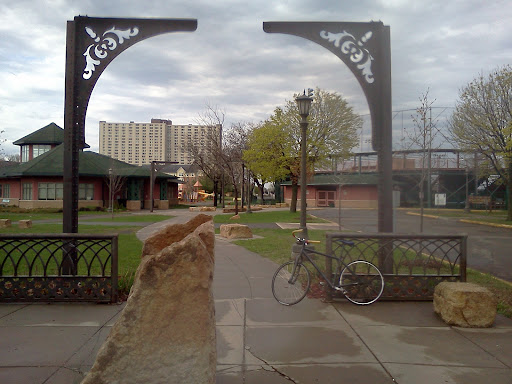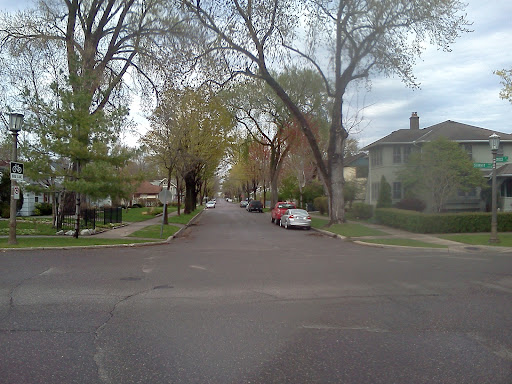Changes ahead for Park and Portland Avenues
 |
| Rendering of potential Park and Portland Avenues (Rendering by Brendon Slotterback) |
Hennepin County will be repaving and restriping Park and Portland Avenues this September. Cycling advocates and residents hope for more than just a touch-up.
Park and Portland have been recognized as dangerous roads for some time now. They have speed limits of 35mph, though the stoplights are timed to 38mph, and cars regularly travel at 45mph or more. The bike lanes are on the left, leaving cyclists inches from the fast lane. In May of 2009, cyclist Dennis Dumm was killed by a left-turning semitrailer. The ghostbike remains at the site of the collision. In December of 2011, Louise M. Laugen was struck and killed crossing Park Avenue at 27th Street.
Park and Portland have a very long history. In the 19th Century, the roads were constructed in an opulent fashion with huge boulevards to have the grandeur of set-back housing. The elite of Minneapolis, many of whom made their fortunes in the milling industry, commissioned architects to build mansions along the “Golden Mile” between 18th and 28th Streets. Further south, upper-middle class families lived in more modest yet still striking architect-designed residences.
Park and Portland were 36-feet-wide two-way roads. The conventional vehicle at this time was the horse-drawn carriage. Horse ownership comes with significant costs, as you must feed and groom the horse, or more than likely employ an ostler. Given the harsh nature of winters in Minneapolis, walking could only take you so far, so only the wealthy could afford to live far from the urban core.
At the end of the 19th Century, the safety bicycle, as opposed to the dangerous penny-farthing, surged in popularity. The Flour City Cycling Club was founded at 1611 Park Avenue and held annual races on Park and Portland Avenue.
After World War II, the suburbs were booming in population growth, Richfield in particular, which tripled in size. To accommodate this growth, Park and Portland were changed to handle suburban commuters. They were converted to one-way roads, and in 1955, the boulevards were removed to add an extra lane. The conversion of Park and Portland to “urban highways” caused many of the elite to move to such places like Lake Minnetonka. The existing mansions became multiunit rental housing until many were tore down in the following decades under the guise of Urban Renewal.
After Interstate 35W was completed in 1967, the need for Park and Portland to serve as urban highways was greatly reduced. The traffic count is now at 13,000 vehicles daily, well below the need for three lanes. With the cycling resurgance in the 1980s through present, bike lanes were added to Park and Portland, though on the left side to avoid dooring.
Currently, Hennepin County at least plans on moving the bike lanes to the right side. Minneapolis Bicycle Coalition President Ethan Fawley also recommends removing one of the traffic lanes and using the space to create protected bike lanes, also known as cycletracks. These bike lanes are controversial due to their haphazard implementation on First Avenue downtown. Falwey is confident that the correct implementation of cycletracks would increase safety and ridership.
Fawley would also like the speed limit lowered to 30mph, but such a change he considers unlikely, as Park and Portland are managed by Hennepin County, and there’s more pushback by the county on reducing speed limits as opposed to the city. Another idea is to reclaim the large boulevards from the Golden Mile days and install planters or community gardens.
The advantage to focusing on Park and Portland at this time is that since there’s already a resurfacing project planned and budgeted, much of the cost is already covered. What would need to be covered is the specific design of intersections and public outreach. However, the funds required are likely in the tens of thousands, which is small compared to the MN Department of Transportation budget which has a budget in the hundreds of millions.
Park Avenue resident and local historian Ryan Knoke sees the redesign of Park and Portland to be more livable as key to investing in the neighborhoods along Park and Portland. Knoke gives walking tours of Park Avenue with a focus on the historic architecture. Knoke, like many others, would prefer a return to two-way residential roads. “As more and more people are moving back into the inner city, this is an excellent opportunity for the City of Minneapolis to reevaluate the overall livability of Park and Portland from both residential and pedestrian- and bike-friendly perspectives.”
The Minneapolis Bicycle Coalition will engage the County, the City of Minneapolis, and neighborhood groups to encourage a reconfiguration of Park and Portland for the resurfacing in September. If a grand remodel is not in place, a start would be to use temporary paint and repaint in a year after additional time for study and outreach.
In a road that has seen more than one major redesign to adapt to a changing transportation reality, say many local residents, a redesign to a more complete street would be a welcome change.






 The learning curve must be steep to reduce a process to one eighth of its former time. Perhaps after such a protracted and emotional conflict over the Jefferson Bikeway, the public sees the process as much ado over such a small something. The learning in the curve involves not just city employees, but also residents. What struck me in researching this article was that so many welcomed the bikeway. In fact, I had to really dig deep to find anything remotely negative.
The learning curve must be steep to reduce a process to one eighth of its former time. Perhaps after such a protracted and emotional conflict over the Jefferson Bikeway, the public sees the process as much ado over such a small something. The learning in the curve involves not just city employees, but also residents. What struck me in researching this article was that so many welcomed the bikeway. In fact, I had to really dig deep to find anything remotely negative.










